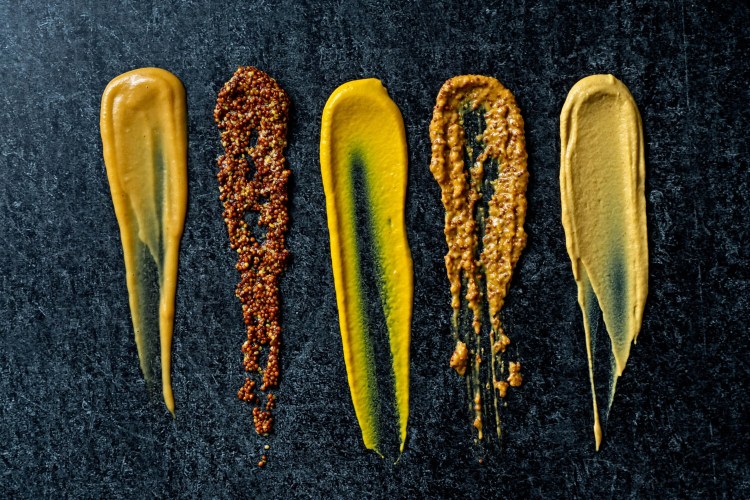For the longest time, yellow mustard was the only version of the condiment I knew. I squiggled it atop hot dogs and watched my father mix it into baked beans. Over the years, my palate has expanded to enjoy other members of the mustard family, and now I typically have at least a handful of jars and bottles in my fridge at any given time for various uses. But even still, there’s so much more to this ubiquitous condiment.
“Mustard is among the top three most used condiments in the world, sharing the stage with salt and pepper. It has been in the pantry of history for at least 4,000 years, and is written in recipes in Europe since the second century,” Demet Güzey writes in “Mustard: A Global History.” “The name ‘mustard’ was born when the Romans mixed unfermented grape juice, must (Latin mustum), with ground mustard seeds and made a hot must, mustum ardens.”
That is essentially the same process employed today, but by altering the type of mustard seeds, how finely they’re crushed, what liquid is added and any additional ingredients, you can create a vast array of mustards.
It all begins with the seed, which comes in three varieties: yellow, brown and black. Black mustard seeds are primarily used as a spice; yellow and brown seeds are used to make the condiment. Of the latter two, brown seeds are more potent, so their use results in spicier mustards. And while the degree to which the seeds are ground obviously impacts the resulting mustard’s texture and consistency, it also affects flavor.
“Although spiciness is a defining characteristic of many styles of mustard, whole mustard seeds don’t start off spicy. Instead, they’re bitter and a little nutty,” Kate Shannon writes at America’s Test Kitchen. “When mustard seeds’ cell walls are crushed and liquid is added, an important chemical change takes place. A reaction converts bitter-tasting glucosinolates into spicy-tasting isothiocyanates, thus removing bitterness and creating heat.” So the more the seeds are left intact, the less spicy and more bitter the resulting mustard.
The choice of the liquid added to the mustard seeds also plays a key role. More acidic liquids can prevent the formation of those spicy molecules, resulting in milder mustards. However, while less acidic liquids will result in more pungent mustards, the spiciness fades over time. The temperature of the liquid is also a factor: “Hot water will deactivate mustard enzymes and break down some of the pungent compounds, while cold water will keep them all intact,” Joshua Bousel writes for Serious Eats. “The mildest mustards with the longest shelf life are made with yellow mustard seeds and plenty of vinegar, while the hottest mustards are made with black or brown mustard seeds and cold water.”

Mustards (clockwise from top middle): yellow, honey, whole grain, Dijon and deli. Photo by Scott Suchman for The Washington Post
Tinkering with each step of the process allows manufacturers to create numerous mustard types. In fact, the National Mustard Museum – yes, such a place exists – counts 5,624 different bottles in its collection. While you might be tempted to try them all, here are five of the most common types you need to know.
– Yellow. This American classic was introduced by the French family – yes, that one – at the St. Louis World’s Fair in 1904. Made with yellow mustard seeds, it actually gets its namesake color from turmeric. A fairly mellow product when it comes to spice – thanks to the high acidity – yellow mustard works as a great all-purpose option, whether as a condiment or an ingredient.
– Dijon. I was introduced to this style by commercials for Grey Poupon, with its air of luxury and sophistication. The name comes from the city in France where it was first made. Produced today with brown seeds and typically with white wine, it has a moderate acidity and can pack quite a punch. Because of its potency, I prefer to mix it with other ingredients to tame its sinus-clearing capabilities, such as in vinaigrettes and sauces.
– Deli. Sometimes labeled “spicy brown” or just simply “brown,” deli mustard, as you can likely infer, is great on sandwiches. It consists of partially ground brown mustard seeds, warming spices and a moderate amount of acid, which results in a flavorful condiment that can certainly live up to the “spicy” moniker.
– Whole grain. Spreads containing whole mustard seeds are generally what I think of, but whole grain can also include coarsely ground mustards. Regardless, if you’re looking for pops of texture, this is the mustard for you. For that reason, I love using it in the various summer salads, such as pasta salad, coleslaw and potato salad.
– Honey mustard. A sauce typically made of equal parts of the ingredients in its name, honey mustard is a go-to dip for chicken nuggets and the like. “Since the goal of honey mustard is to bring sweetness to a sauce that’s known for its heat and bitterness, yellow is the most common mustard used, because it starts with an already mild flavor that’s easy to tame further with honey,” Bousel writes. I prefer to make my own honey mustard with Dijon for a more flavorful, spicy-sweet sauce.
Recipes that call for mustard will generally specify a type, but understanding their differences will allow you to use various mustards interchangeably while adjusting the amounts according to their levels of acidity and spice. And while mustards won’t go bad, they will lose their potency over time, and flavor and appearance can change due to oxidation. Because of this, it’s best to store them in the refrigerator (though this isn’t necessary), and you might want to consider replacing mustards you’ve had for more than a year.
Copy the Story LinkComments are not available on this story.
Send questions/comments to the editors.


